
|
Sale 24
Manuscript and Collectibles Auction
| Autographs-Signers of The U.S. Declaration of Independance |
| |
| |
| Lot |
Photo |
Description |
Realized |
Lot 201 |
 |
Adams, Samuel. Partly-printed Document Signed twice as tax collector for Boston, on the front "S. Adams" and on the verso, "Saml. Adams," with holograph notation, "Recd in full," Boston, 1763, 1 pg., 4 x 5¼ in., inlaid. Tax assessment No. 10, to Harrison Gray, Esqr., in the amount of £13.3.3 for province taxes and £24.10.9 for town and county rates. A printed statement at the bottom of the form says, "The Assessors sit at Faneuil-Hall in Boston, on Thursdays, from 3 to 5 of the Clock Afternoon, to whom any Person aggrieved may apply for Ease, as the Law directs." Overall toning; some show-though from writing on verso.
Samuel Adams was tax collector for Boston 1756-64. As a member of the Massachusetts legislature (1765-74), he organized opposition to the Stamp Act (1765), organized the Non-Importation Association (1768), helped found the Boston Committee of Correspondence (1772), and was a leader in the agitation that lead up to the Boston Tea Party. He was a delegate to the first and second Continental Congresss, signed the Declaration of Independence, was a member of Congress (to 1781), and was governor of Massachusetts (1794-97).
Estimated Value $2,500 - 3,000.
View details and enlarged photo
| Realized
$2,875 |
Lot 202 |
 |
Chase, Samuel (1741-1811) Signer of the Declaration of Independence. Autograph Letter Signed as associate justice of the U.S. Supreme Court, Baltimore, July 9, 1804, 1 pg octavo. Addressed to William Tilghman in Philadelphia. Chase recommends a Mr. Attenberry to fill a banking position. In part, "I hear that there are several vacanies in the Branch Bank in this City. I beg leave to recommend Mr. Attenberry to fill one of them. I believe him to be very worthy of…trust. I hope he will receive your Patronage…." Light toning; otherwise, Fine. Chase is in the rare group of signers, considered a 3 out of 5 in rarity.
At the time of this letter, at the instigation of President Jefferson, proceedings were under way to impeach Chase. His acquittal in 1805 strengthened the independence of the judiciary. Chase served on the Maryland committee of correspondence in 1774, was a delegate to the Continental Congress from 1774 to 1778, and again in 1784 and 1785. He signed the Declaration of Independence, but opposed the adoption of the Constitution. He was associate justice of the U.S. Supreme Court from 1796 to 1811. A recommendation from Chase in 1804 might have had an adverse, rather than a positive, effect. William Tilghman had served as a senator from Maryland before moving to Philadelphia to practice law and becoming Chief Justice of the Pennsylvania Supreme Court.
Estimated Value $4,000 - 6,000.
View details and enlarged photo
| Unsold |
Lot 203 |
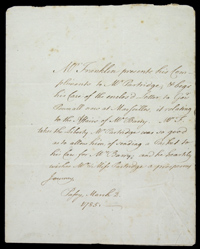 |
Franklin, Benjamin (1706-1790) One of America's leading founding fathers, signer of the Declaration of Independence and the U.S. Constitution, accomplished diplomat and statesman, and renowned inventor. Autograph Letter Signed twice in the third person, once as "Mr. Franklin" and once as "Mr. F," Passy (France), March 2, 1785, 9¼ x 7¼ in. Clearly written in bold brown ink with light overall toning and minor foxing; light creasing at lower right. Docket on verso of integral leaf; a few dark ink spots on integral leaf affect nothing.
Franklin writes, in full: "Mr. Franklin presents his Compliments to Mr. Partridge, & begs his Care of the enclos'd Letter to Govr. Pownall now at Marseilles, it relating to the Affairs of Mr. Barry. Mr. F. takes the Liberty Mr. Partridge was so good as to allow him of sending a Packet to his Care for Mr. Barry; and he heartily wishes Mr. & Miss Partridge a prosperous Journey. Passy, March 2, 1785."
The letter was written from Franklin's home in Passy, outside of Paris, six months before he returned to the United States, after spending nine years in France. He was sent by Congress in 1776, as one of a committee of three, to negotiate a treaty with France. In September 1778, he was appointed sole plenipotentiary to France, and in 1781, he was appointed commissioner, along with John Jay and John Adams, to negotiate peace with Great Britain. The final peace was signed September 3, 1783. After returning to Philadelphia, Franklin was president of the Pennsylvania executive council ((1785-87), and was a member of the Constitutional Convention in 1787.
John Barry (1745-1803), whose affairs Franklin mentions, was a naval officer during the American Revolution, whose fame was second only to John Paul Jones. In 1776, he was appointed to command the brig Lexington and captured the British tender Edward, which was the first ship ever taken by a commissioned officer of the U.S. Navy. In 1778, Barry became commander of the Raleigh, which was pursued and driven ashore by a British man-of-war. In 1781, as commander of the Alliance, he captured the British ships Trepassy and Atlanta. As a result of his outstanding record, Barry was named senior captain, the highest post in the Navy at that time, and was given the courtesy title of commodore. In 1794, he was made commodore of the United States, one of the Navy's new flagships. From 1798 to 1801, he directed American naval operations in the West Indies.
Estimated Value $20,000 - 25,000.
View details and enlarged photo
| Realized
$11,500 |
Lot 204 |
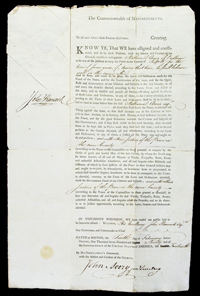 |
Hancock, John & Adams, Samuels (1737-93) and (1722-1803), Signers of the Declaration of Independence from Massachusetts. Partly printed Document Signed as Governor and Lieutenant Governor of Massachusetts, Boston, February 10, 1790, 1 pg., 17½ x 11 in. Appointing "Nathaniel Ames of Dedham to be one of the Justices to keep the Peace in our County of Suffolk for the team of seven years, if, during that, he shall behave well in the same office…." John Hancock's beautiful signature is at upper left, under the paper seal. Samuel Adams signs ("S. Adams") on the verso, acknowledging that Ames had taken the necessary oaths of office. John Avery signs as Secretary of the Commonwealth of Massachusetts on the front bottom. The fold to the right of Hancock's signature is cleanly split to the center and there are a few other partial fold splits. Other than these easily-repaired splits and light toning, the document is very attractive and ideal for framing.
Estimated Value $10,000 - 12,000.
View details and enlarged photo
| Unsold |
Lot 205 |
 |
Hooper, William (1742-90) Signer of the Declaration of Independence. Autograph Document Signed ("Will Hooper Attrn Dom Reg") as attorney for the King, Superior Courts of Justice, Salisbury, North Carolina, September 5, 1768, 1 pg legal folio. Regarding the law suit of John Parker Vs. Daniel Clay. Hooper pens, in part, "The jurors for our Sovereign Lord the King upon their Oath present, that John Parker late of the county of rowan, Planter on the twenty second day of August in the Eighth year of the reign of our Sovereign Lord George the Third of Great Britain France and Ireland, King Defender of the Faith…with Force and Arms one Horse of the value of Six pence Sterling money of Great Britain of the goods and Chattels of one Daniel Clary then and there…did forcibly take and impound and retain in his Possession against the peace…." Moderate toning; some soiling and marginal chipping; a few small archival repairs on verso, else Very Good. Hooper's signature is a bold, handsome example. Hooper is in the very rare group of signers, considered a 4 out of 5 in rarity.
William Hooper was born in Boston; he graduated Harvard and studied law under James Otis, then settled in Wilmington, North Carolina in 1767. He represented Wilmington in the general assembly of 1773, in which he opposed the arbitrary measures of the crown and wrote a series of essays under the name "Hampden." He served in the Continental Congress from 1774 to 1777. After signing the Declaration of Independence, he served on committees regulating the post office, treasury, secret correspondence, appeals from the admiralty courts, and the laws relating to captures. In 1786, he was part of a commission to settle a boudary dispute between New York and Massachusetts. He filled various public offices in North Carolina until his retirement in 1787.
Estimated Value $5,000 - 6,000.
View details and enlarged photo
| Realized
$5,750 |
Lot 206 |
 |
Hopkins, Stephen (1707-1785) Signer of the Declaration of Independence from Rhode Island. Manuscript Document Signed ("Step. Hopkins"), Newport, August 16, 1755, 1 pg., 4½ x 7½ in. A pay order to Thomas Richardson, General Treasurer of Rhode Island to "pay to Daniel Jenckes or order four thousand pounds old Tenor for the use of Rasing the additional forces against Crown point and other Charges accrued on Rasing the former forces and Charge the Same to the Colony." Signed by two other members of the committee. Light overall toning. Inlaid to a slightly larger sheet; small piece of paper is attached to lower blank margin. Hopkins became colonial governor of Rhode Island in 1756. He was one of the earliest champions of colonial rights against the English parliament. Crown Point, on Lake Champlain, was one of a series of forts built by the French to prevent British encroachment into the Great Lakes and Ohio River Valley area. Despite ongoing military actions, war was not formally declared between France and Great Britain until May 1756, some two years after the outbreak of hostilities.
Estimated Value $600 - 800.
View details and enlarged photo
| Realized
$546 |
Lot 207 |
 |
Lee, Richard Henry (1732-1794) Signer of the Declaration of Independence. Autograph Document Signed (Westmoreland County, Virginia) December 9, 1761, 1 pg small quarto. A legal document binding Fleming Patterson and Hugh West to John McCarty for the sum of 14 pounds. The document is signed by Patterson and West, with red wax seals next to their signatures, and acknowledged before Lee, who was Justice of the Peace of Westmoreland County, although his title is not mentioned in the document. Overall toning, but boldly penned and signed. A nice example for framing. Lee is in the rare group of signers, considered a 3 out of 5 in rarity.
Lee was from a weathy family and did not have to work, but he avidly studied law and history. As a member of the Virginia House of Burgesses from 1758 to 1775, he spoke out against slavery, asking the burgesses "to lay so heavy a duty on the importation of slaves as effectually to put an end to that iniquitous and disgraceful traffic within the colony of Virginia." He opposed the Stamp Act, leading his company of light horse to the resident collector's house and confiscating and burning his commission and papers. In 1773 he initiated, with Patrick Henry and Thomas Jefferson, intercolonial committees of correspondence. Lee was a delegate to the Continental Congress from 1774 to 1779. On June 7, 1776, he moved the resolution (adopted July 2) that led directly to the writing of the Declaration of Independence, which he signed, as well as the Articles of Confederation. He was in the Congress again from 1784 to 1789, serving as President 1784-85. From 1789 to 1792 he was a member of the U.S. Senate.
Estimated Value $3,000 - 4,000.
View details and enlarged photo
| Realized
$4,888 |
Lot 208 |
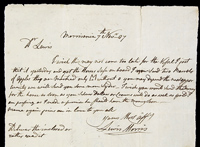 |
Morris, Lewis (1726-1798) Signer of the Declaration of Independence. Autograph Letter Signed, Morrisania (New York), November 7, 1787, 1 pg folio. Written to his eldest son, Col. Lewis Morris, in Charleston, South Carolina: "I wish this may not come too late for the vessel. I just …it yesterday and got the Morris safe on board. I now send two Barrels of Apples they are marked only M without. You may depend the next opportunity we will Send you Some more Syder. I wish you would Send the money for the horse as soon as you silver Dollars or Crowns will do as well as gold. I am pressing as I made a promise he should have the money soon. Mama again joins me in love to you all…." A note of instruction at lower left says, "Deliver the inclosed or rather read it." Light toning; a closed tear at left edge affects three lines of text, but is not very obvious. Boldly penned and signed. Lewis Morris was a member of the Continental Congress from 1775 to 1777 and signed the Declaration of Independence. He is in the rare group of signers, considered a 3 out of 5 in rarity.
Estimated Value $1,800 - 2,000.
View details and enlarged photo
| Unsold |
Lot 209 |
 |
Morris, Robert (1734-1806) Signer of the Declaration of Independence. Exceedingly rare Document Signed ("Robt Morris") as chairman of the Secret Committee, Philadelphia, October 31, 1776, 1 pg, 4½ x 8 in. Written "To the honble. / Council of Safety / Pennsylvania," in full: "The Ship Mary & Elizabeth Capt Young in the Continental Service is going down the River and will want a pilot. You will please to order one for Said vessel. and oblige Gentlemen Your very hbl Svrt…." Moderate to heavy toning; one closed tear in blank upper right corner; archivally backed for preservation. Morris' signature is bold. Although Morris' signature can usually be found on financial documents or post-Revolutionary War documents regarding land speculation, a document signed in 1776 as chairman of the Secret Committee is extremely rare!
The Secret Committee was created by resolution of the Second Continental Congress on September 18, 1775. Morris was its chairman and its members included Benjamin Franklin, Robert Livingston, John Dickinson, Thomas Willing, Thomas McKean, John Langdon, and Samuel Ward. It was given wide powers and large sums of money to obtain military supplies in secret, and was charged with distributing the supplies and selling gunpowder to privateers chartered by the Continental Congress. The Committee also administered the secret contracts for arms and gunpowder previously negotiated without the formal sanction of Congress. The Secret Committee often worked in cooperation with the Committee of Secret Correspondence, employing agents overseas to gather intelligence about Tory secret ammunition stores and arranging to seize them. It also arranged missions to plunder British supplies in the southern colonies. Military stores were purchased through intermediaries to conceal the fact that the Continental Congress was the true purchaser. The Secret Committee also used foreign flags to protect its vessels from British ships. Since the Committee's transactions were secret, many of its records were destroyed to assure confidentiality. It is rare to find one extant.
Estimated Value $5,000 - 6,000.
View details and enlarged photo
| Realized
$7,130 |
Lot 210 |
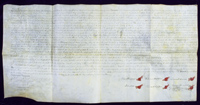 |
Morris, Robert (1734-1806). Enormous vellum Document Signed, August 22, 1797 (New Jersey), 16¼ x 32½ inches. A land indenture, with eight signatories and large, bold Robert Morris signature as witness attorney to the transaction between Peter Hammond, president of the West New Jersey Society, and James, Sarah, Phoebe and Ann Whellen for land in Pennsylvania "granted and conveyed by Robert Morris." Red wax seals are intact. Normal age toning, otherwise Fine. Robert Morris was a signer of the Declaration of Independence, a signer of the Articles of Confederation, a signer of the Constitution, and a founder of the Bank of North America. He was also the financial wizard behind the Revolutionary War. Morris, unfortunately, ended in debtor's prison from 1798 to 1801 because of his feckless land speculation, which this 1797 document may partially represent. A wonderful historical document for matting and framing.
Estimated Value $900 - 1,200.
View details and enlarged photo
| Realized
$1,035 |
Lot 211 |
 |
Nelson, Thomas Jr (1738-1789) Signer of the Declaration of Independence; Governor of Virginia. Partly-printed Document Signed ("Thos Nelson jr) as a witness, Virginia, September 7, 1768, 1 pg, quarto. Nelson witnesses the execution of a bond for two hundred fifty-three pounds and five shillings between Warner Washington of Gloucester Counter and David Ker of King & Queen County. Nelson signs as the last of three witnesses, at lower left. The document is written on laid paper that is watermarked with a crown and the initials "GR"; it has been archivally backed with japan paper for preservation. Nelson's signature is bold; it has been lightly circled with a pencil and there is some show-through from notations on verso. Nelson is in the very rare group of signers, considered a 4 out of 5 in rarity. Only Button Gwinnett and Thomas Lynch, Jr. are rarer.
Nelson was a member of the Continental Congress from 1775 to 1777 and in 1779. In August 1777, when the British fleet approached, he was appointed commander-in-chief of the Virginia state forces. He raised a troop and became their banker. In June 1780, the state of Virginia called for $2,000,000 to be placed in the Continental treasury to provide for the French fleet. Nelson raised much of the money on his personal security, which he later redeemed at great loss and for which he received no compensation from the government. He also advanced money to pay two Virginia regiments that refused to march until they were paid. At the siege of Yorktown, he commanded the Virginia militia. General Washington mentioned Nelson in his general orders after Yorktown, thanking "his excellency, Gov. Nelson, for the succors which he received from him, to whose activity, emulation, and bravery the highest praises are due." Nelson died in 1781.
Estimated Value $5,000 - 6,000.
View details and enlarged photo
| Unsold |
Lot 212 |
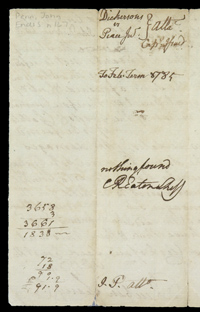 |
Penn, John (1741-88) Signer of the Declaration of Independence and the Articles of Confederation; he represented North Carolina in Congress. Manuscript Document Endorsed ("J.P. atto.") as attorney in a case between John Dickerson and John Peace, in Granville County, North Carolina, November 1, 1784. Overall toning; minor tape repair and some fold splits. The endorsement is bold. John Penn is very hard to find, being a 4 out of 5 in rarity.
Estimated Value $1,200 - 1,500.
View details and enlarged photo
| Unsold |
Lot 213 |
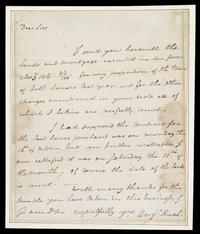 |
Rush, Benjamin (1745-1813) Signer of the Declaration of Independence. Autograph Letter Signed ("Benjn. Rush"), no place, no date, 1 pg octavo, inlaid to a slightly larger sheet. To an unidentified correspondent: "I send you herewith the bonds and mortgage executed in due form…$124.84 for my proportion of the taxes of both houses last year and for the other charges mentioned in your note all of which I believe are perfectly correct. / I had supposed the contract for the last house purchased was on Monday the 13th of October, but upon further recollection I am satisfied it was on Saturday the 11th: of the month; of course the date of the bond is correct. / With many thanks for the trouble you have taken in this business…." Light toning, else Fine. Rush is in the rare group of signers, considered a 3 out of 5 in rarity.
Benjamin Rush was a Philadelphia physician and educator. He taught chemistry at the College of Philadelphia from 1769 to 1791, and at the University of Pennsylvania in 1791. He was a member of the Continental Congress in 1776-77 and signed the Declaration of Independence. He was surgeon general of the Continental Congress 1777-78. In 1786 he established the first free dispensary in the U.S. and in 1787 attended the Constitutional Convention. From 1787 to 1813, he was treasurer of the U.S. Mint. He was the author of several books, including the first chemistry textbook in the U.S. and the first psychiatric treatise in the U.S.
Estimated Value $2,500 - 3,000.
View details and enlarged photo
| Realized
$2,990 |
Lot 214 |
 |
Stockton, Richard (1730-81) Signer of the Declaration of Independence. Autograph Document Signed twice, once ("Richd Stockton") at the end and once in full in the text, New Jersey Supreme Court (filed November term 1769), 1½ pp folio (one sheet). Stockton writes as attorney for Abraham Causee and Jonathan Combs, administrators of the estate of Martha Wilkins, deceased, defending them against a charge of trespass brought by William Wilkins. Light toning and soiling; small area of paper loss at right margin affects two letters; otherwise, Very Good.
Stockton is in the very rare group of signers, being a 4 out of 5 in rarity. Richard Stockton practiced law in New Jersey. He was a member of the executive council of New Jersey (1768-76), an associate justice of the New Jersey supreme court (1774-76), and served in the Continental Congress in 1776.
Estimated Value $2,500 - 3,000.
View details and enlarged photo
| Unsold |
Lot 215 |
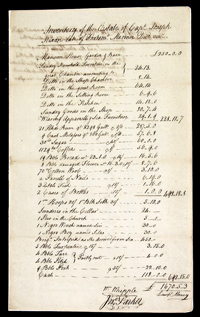 |
Whipple, William (1730-1785) Signer of the Declaration of Independence. Manuscript Document Signed ("Wm. Whipple") (Portsmouth, New Hampshire, January 18, 1770), 1pg. folio. Certifying the appraisal of the household goods of Captain Joseph Hixon of Portsmouth, Mariner, Deceased. The captain's most valuable possessions were his brigantine Intrepid, valued at 459 pounds, his house, garden, and barn at 250 pounds, and 21 hogsheads of rum at 287.5 pounds. Among the other articles listed are his church pew, household and sea furniture. Valued at 30 pounds each are "1 Negro Wench named Lois" and "1 Negro Boy named Silas." The document is darkly penned and Whipple's signature is bold. Whipple is in the rare group of Signers, considered a 3 out of 5 in difficulty to acquire.
Whipple himself was a sailor in his youth and, among other endeavors, engaged in the slave trade. In 1759, he abandoned the sea and became a businessman. During the Revolution, he freed his own slaves. He served as a member of the Continental Congress from New Hampshire (1776-79), signing the Declaration of Independence. In 1777 he commanded militia contingents in the Saratoga campaign, and signed the articles of capitulation with Col. James Wilkinson on behalf of Gen. Horatio Gates. He participated in Gen. Sullivan's unsuccessful Rhode Island campaign in 1778. From 1782-85, he served as associate justice of the superior court in New Hampshire.
Estimated Value $2,000 - 3,000.
View details and enlarged photo
| Realized
$2,875 |
Lot 216 |
 |
Wilson, James (1742-1798) Signer of the Declaration of Independence from Pennsylvania. Book Signed in full on the title page, being Wilson's personal copy of A Philosophical and Political History of the Settlements and Trade of the Europeans in the East and West Indies, Vol. II, translated from the French by J. Justamond, London: Printed for T. Cadell, in the Strand, 1777, 595 pp. Gilt lettering against burgundy on the spine. Leather covers are scuffed and worn, and the front cover, along with an end paper and the signed title page, is detached; the spine is rough and missing small areas of leather at top and bottom. A 13 x 18 in. "Map of the European Settlements in South American and on the Western Coast of Africa" by Thomas Kitchin is folded into the front of the book. Interior has light overall toning and some scattered foxing. Housed in a custom-made blue case with black spine and gilt lettering. Wilson's signature is most often seen on the verso of legal documents, signed only with his last name. A full signature in a book that belonged to him is much less common.
Estimated Value $2,250 - 2,500.
View details and enlarged photo
| Unsold |
Lot 217 |
|
Withdrawn
| Unsold |
Lot 218 |
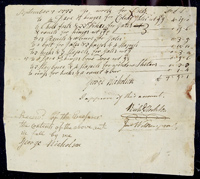 |
Witherspoon, John & Stockton, Richard. Signers of the Declaration of Independence. Document Signed ("Jno Witherspoon"), as president of the College of New Jersey (now Princeton University) and ("Richd. Stockton") as a member of the executive council of New Jersey (Princeton), September 1, 1772, 1 pg oblong octavo. The document authorizes payment for work done at the college, including repairs to gates and windows. Slight skipping of ink in Witherspoon's signature, which is of moderate boldness; Stockton's is quite bold. Minor archival repairs on verso; light toning and soiling, else Very Good. Stockton and Witherspoon are both in the very rare group of signers, both being a 4 out of 5 in rarity.
John Witherspoon immigrated to America in 1768 to become President of the College of New Jersey, his special department being devinity. His leadership healed the schism between the New Side and Old Side Presbyterians. He was a member of the Continental Congress (1776-79, 1780-81, 1782) and signed the Declaration of Independence. He was also a member of the New Jersey constitutional ratification convention (1787). Richard Stockton's family was long involved in affairs of the College of New Jersey. Stockton had visited Witherspoon in Scotland to offer him the college presidency. Stockton was an associate justice of the New Jersey supreme court (1774-76) and served in the Continental Congress in 1776.
Estimated Value $6,000 - 8,000.
View details and enlarged photo
| Realized
$10,005 |
|
|